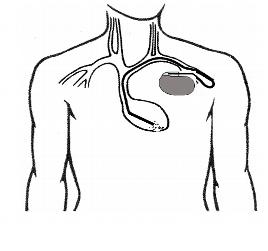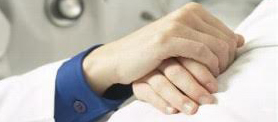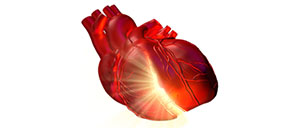Sick Sinus Syndrome
Sick sinus syndrome (SSS) is a generic name given to a group of conditions implying disease of the native sinus, or sinoatrial (SA), node, the pacemaker site of a normal heart. As explained in earlier sections, the sinus node is the normal pacemaker of the heart located in the right atrium, and is responsible for the regular rhythmic beating of the heart. The electrical signal the sinus nodegenerates spreads out in a centrifugal fashion to the top two atria, resulting in synchronous contraction of blood from the atria into the ventricle. The sinus node normally depolarizes at a rate of 60 to 100 impulses per minute, thus controlling the baseline heart rate. The sinus node is exquisitely sensitive and can increase or decrease the heart rate depending on levels of stress, caffeine, and exercise.
Sick sinus syndrome can be symptomatic and reflects a disturbance in the normal function of the sinus node. It can be manifested by any of the following conditions: 1)inappropriately slow heart rate or bradycardia despite the body’s demands, 2)inappropriately fast heart rate or tachycardiaeven at rest, 3)alternating abnormally slow and fast heart rates (tachycardia-bradycardia syndrome), or 4)sinus pauses or arrest when impulse formation ceases for at least 2-3 second intervals.
Sick sinus syndrome occurs in equal amounts in men and women and increases with age as the normal conduction system, or wiring of the heart, becomes increasingly fibrotic with wear and tear of the sinus node. It can also be exacerbated or manifest in patients on other cardiac medications that affect the sinus node’s normally rhythmic firing. It affects approximately 3 in 10,000 people. Some patients may have inappropriately fast heart rates or tachycardias that require medications to slow down the heart rate response. With the introduction of these cardiac medications, the normal sinus node function may be suppressed enough that the patient becomes symptomatic. In addition, patient’s who have suffered heart attacks may have sustained damage to the sinus nodewith resultant SSS. Other conditions leading to SSS include obstructive sleep apnea, thyroid disease, congenital heart disease, muscular dystrophy, and infiltrative heart diseases such as amyloid or sarcoid.
Symptoms
The symptoms of SSS are typically a direct result of the fast versus slow heart rates. These include palpitations, skipped-beats, dizziness, lightheadedness, syncope (loss of consciousness), fatigue and weakness, confusion, and even angina (chest pain). However, any symptoms of syncope or chest pain require urgent medical evaluation to rule out other more dangerous causes.
Diagnosis
The diagnosis of SSS is typically given based on electrocardiogram (EKG) tracings during the episodes. This can be performed during a routine 12-lead EKG in your physician’s office or hospital, or by outpatient monitoring via an ambulatory Holter or Event monitor.
Some patients with sick sinus syndrome do not have symptoms, with the diagnosis suggested during physical examination by their physicians. These signs include: a slower than normal pulse rate, irregular heart rhythm or pauses by auscultation, escape rhythms from alternate intracardiac pacemaker sites on a 12-lead EKG, a heart rhythm that alternates between slow and fast rates, and low blood pressure.
Treatment
There is no clear medical treatment of symptomatic SSS. In patients who need medications to slow down fast heart rhythms, the slow heart rate is an inavoidable consequence. As well, in those with abnormally diseased sinus nodes and pauses, no reliable outpatient medication is available to heal the sinus node at this time. Given these limitations, patients with symptomatic SSS are referred for placement of a pacemaker system. This procedure is described in depth in the pacemaker section, but in brief, it involves the creation of a pocket under the skin of the upper chest for the small electronic pacemaker device to be implanted.

Electrical signals from the pacemaker are delivered to the heart via one or two implantable intracardiac leads inserted through the veins of the chest underneath the clavicle. The pacemaker’s electronic circuitry will monitor the heart rhythm and rate 24 hours a day, seven days a week. It will deliver an electrical impulse and pace the heart, only when the heart rate slows or there is a pause, thus eliminating symptomatic episodes of bradycardia (slow heart rate).





 Silver Spring Office
Silver Spring Office  DC Office (at Providence Hospital)
DC Office (at Providence Hospital)  Hagerstown Office
Hagerstown Office